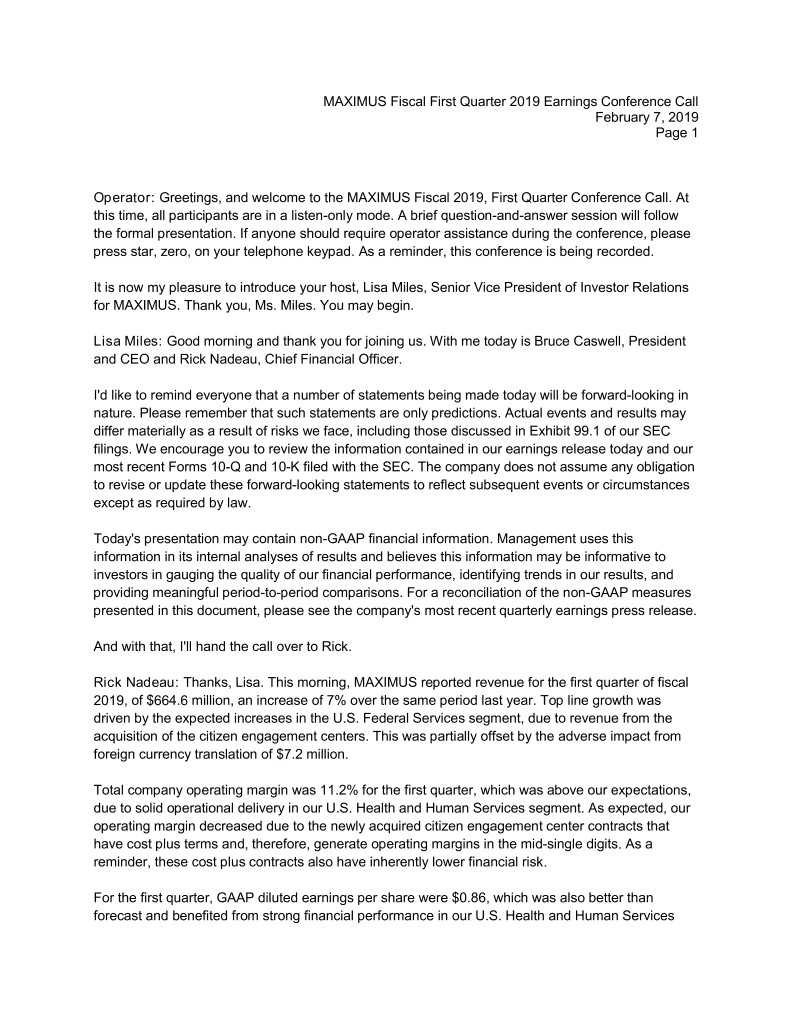
MAXIMUS Fiscal First Quarter 2019 Earnings Conference Call February 7, 2019 Page 1 Operator: Greetings, and welcome to the MAXIMUS Fiscal 2019, First Quarter Conference Call. At this time, all participants are in a listen-only mode. A brief question-and-answer session will follow the formal presentation. If anyone should require operator assistance during the conference, please press star, zero, on your telephone keypad. As a reminder, this conference is being recorded. It is now my pleasure to introduce your host, Lisa Miles, Senior Vice President of Investor Relations for MAXIMUS. Thank you, Ms. Miles. You may begin. Lisa Miles: Good morning and thank you for joining us. With me today is Bruce Caswell, President and CEO and Rick Nadeau, Chief Financial Officer. I'd like to remind everyone that a number of statements being made today will be forward-looking in nature. Please remember that such statements are only predictions. Actual events and results may differ materially as a result of risks we face, including those discussed in Exhibit 99.1 of our SEC filings. We encourage you to review the information contained in our earnings release today and our most recent Forms 10-Q and 10-K filed with the SEC. The company does not assume any obligation to revise or update these forward-looking statements to reflect subsequent events or circumstances except as required by law. Today's presentation may contain non-GAAP financial information. Management uses this information in its internal analyses of results and believes this information may be informative to investors in gauging the quality of our financial performance, identifying trends in our results, and providing meaningful period-to-period comparisons. For a reconciliation of the non-GAAP measures presented in this document, please see the company's most recent quarterly earnings press release. And with that, I'll hand the call over to Rick. Rick Nadeau: Thanks, Lisa. This morning, MAXIMUS reported revenue for the first quarter of fiscal 2019, of $664.6 million, an increase of 7% over the same period last year. Top line growth was driven by the expected increases in the U.S. Federal Services segment, due to revenue from the acquisition of the citizen engagement centers. This was partially offset by the adverse impact from foreign currency translation of $7.2 million. Total company operating margin was 11.2% for the first quarter, which was above our expectations, due to solid operational delivery in our U.S. Health and Human Services segment. As expected, our operating margin decreased due to the newly acquired citizen engagement center contracts that have cost plus terms and, therefore, generate operating margins in the mid-single digits. As a reminder, these cost plus contracts also have inherently lower financial risk. For the first quarter, GAAP diluted earnings per share were $0.86, which was also better than forecast and benefited from strong financial performance in our U.S. Health and Human Services
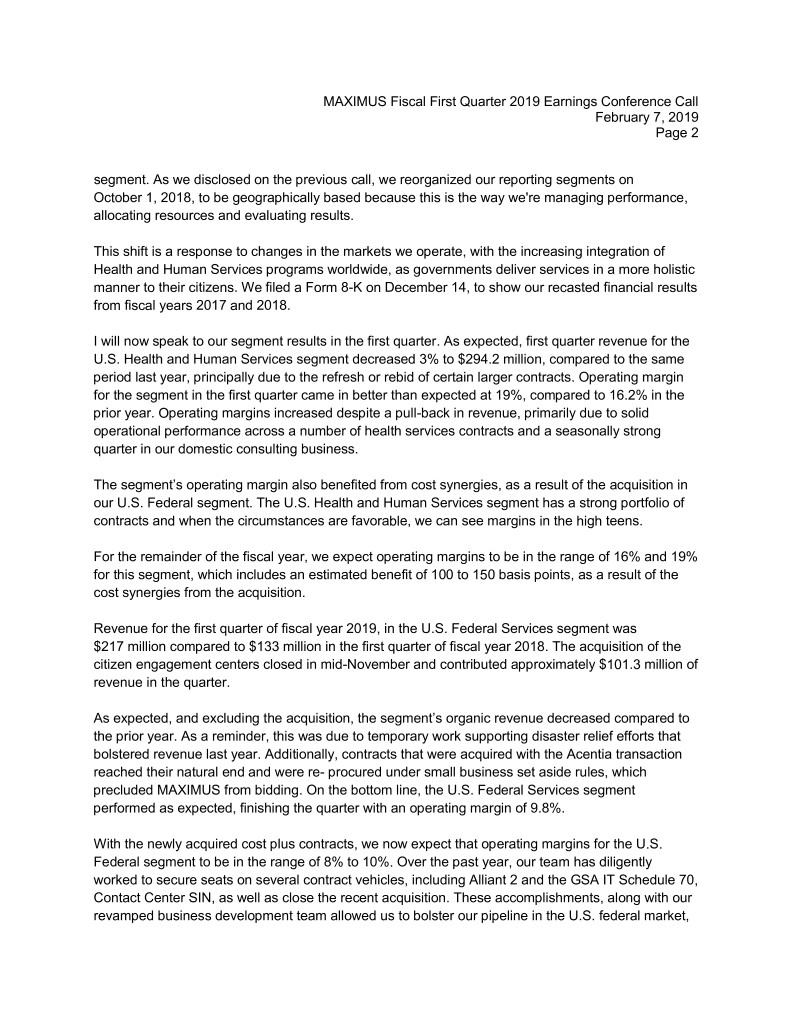
MAXIMUS Fiscal First Quarter 2019 Earnings Conference Call February 7, 2019 Page 2 segment. As we disclosed on the previous call, we reorganized our reporting segments on October 1, 2018, to be geographically based because this is the way we're managing performance, allocating resources and evaluating results. This shift is a response to changes in the markets we operate, with the increasing integration of Health and Human Services programs worldwide, as governments deliver services in a more holistic manner to their citizens. We filed a Form 8-K on December 14, to show our recasted financial results from fiscal years 2017 and 2018. I will now speak to our segment results in the first quarter. As expected, first quarter revenue for the U.S. Health and Human Services segment decreased 3% to $294.2 million, compared to the same period last year, principally due to the refresh or rebid of certain larger contracts. Operating margin for the segment in the first quarter came in better than expected at 19%, compared to 16.2% in the prior year. Operating margins increased despite a pull-back in revenue, primarily due to solid operational performance across a number of health services contracts and a seasonally strong quarter in our domestic consulting business. The segment’s operating margin also benefited from cost synergies, as a result of the acquisition in our U.S. Federal segment. The U.S. Health and Human Services segment has a strong portfolio of contracts and when the circumstances are favorable, we can see margins in the high teens. For the remainder of the fiscal year, we expect operating margins to be in the range of 16% and 19% for this segment, which includes an estimated benefit of 100 to 150 basis points, as a result of the cost synergies from the acquisition. Revenue for the first quarter of fiscal year 2019, in the U.S. Federal Services segment was $217 million compared to $133 million in the first quarter of fiscal year 2018. The acquisition of the citizen engagement centers closed in mid-November and contributed approximately $101.3 million of revenue in the quarter. As expected, and excluding the acquisition, the segment’s organic revenue decreased compared to the prior year. As a reminder, this was due to temporary work supporting disaster relief efforts that bolstered revenue last year. Additionally, contracts that were acquired with the Acentia transaction reached their natural end and were re- procured under small business set aside rules, which precluded MAXIMUS from bidding. On the bottom line, the U.S. Federal Services segment performed as expected, finishing the quarter with an operating margin of 9.8%. With the newly acquired cost plus contracts, we now expect that operating margins for the U.S. Federal segment to be in the range of 8% to 10%. Over the past year, our team has diligently worked to secure seats on several contract vehicles, including Alliant 2 and the GSA IT Schedule 70, Contact Center SIN, as well as close the recent acquisition. These accomplishments, along with our revamped business development team allowed us to bolster our pipeline in the U.S. federal market,
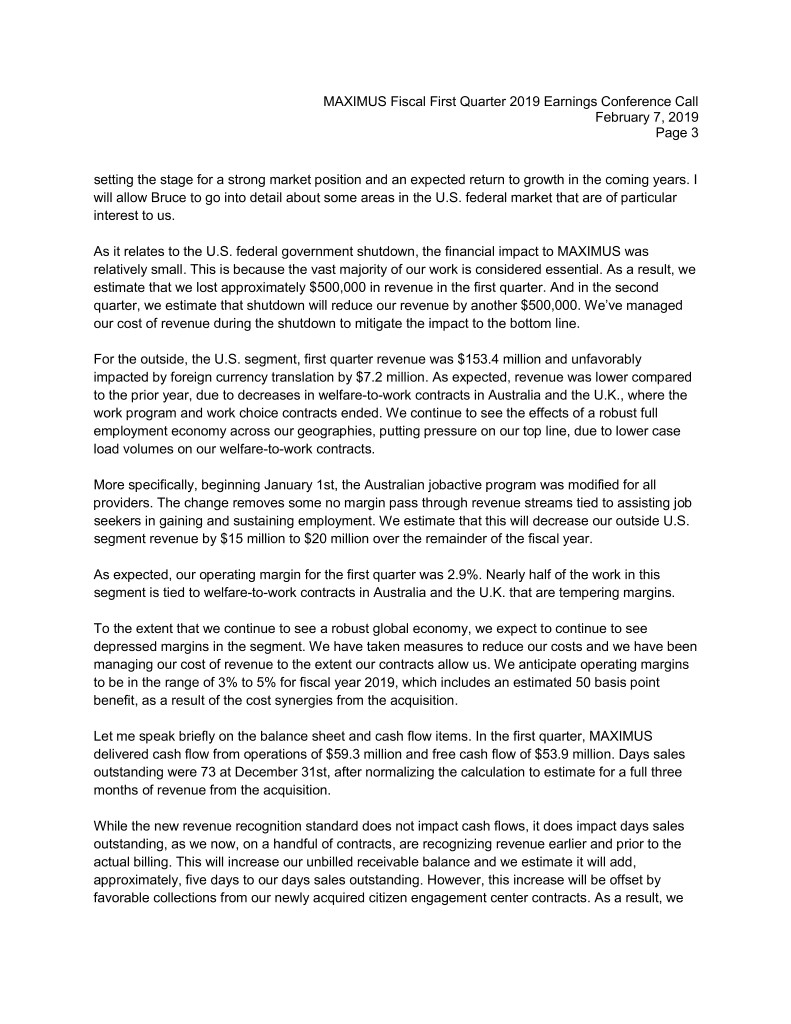
MAXIMUS Fiscal First Quarter 2019 Earnings Conference Call February 7, 2019 Page 3 setting the stage for a strong market position and an expected return to growth in the coming years. I will allow Bruce to go into detail about some areas in the U.S. federal market that are of particular interest to us. As it relates to the U.S. federal government shutdown, the financial impact to MAXIMUS was relatively small. This is because the vast majority of our work is considered essential. As a result, we estimate that we lost approximately $500,000 in revenue in the first quarter. And in the second quarter, we estimate that shutdown will reduce our revenue by another $500,000. We’ve managed our cost of revenue during the shutdown to mitigate the impact to the bottom line. For the outside, the U.S. segment, first quarter revenue was $153.4 million and unfavorably impacted by foreign currency translation by $7.2 million. As expected, revenue was lower compared to the prior year, due to decreases in welfare-to-work contracts in Australia and the U.K., where the work program and work choice contracts ended. We continue to see the effects of a robust full employment economy across our geographies, putting pressure on our top line, due to lower case load volumes on our welfare-to-work contracts. More specifically, beginning January 1st, the Australian jobactive program was modified for all providers. The change removes some no margin pass through revenue streams tied to assisting job seekers in gaining and sustaining employment. We estimate that this will decrease our outside U.S. segment revenue by $15 million to $20 million over the remainder of the fiscal year. As expected, our operating margin for the first quarter was 2.9%. Nearly half of the work in this segment is tied to welfare-to-work contracts in Australia and the U.K. that are tempering margins. To the extent that we continue to see a robust global economy, we expect to continue to see depressed margins in the segment. We have taken measures to reduce our costs and we have been managing our cost of revenue to the extent our contracts allow us. We anticipate operating margins to be in the range of 3% to 5% for fiscal year 2019, which includes an estimated 50 basis point benefit, as a result of the cost synergies from the acquisition. Let me speak briefly on the balance sheet and cash flow items. In the first quarter, MAXIMUS delivered cash flow from operations of $59.3 million and free cash flow of $53.9 million. Days sales outstanding were 73 at December 31st, after normalizing the calculation to estimate for a full three months of revenue from the acquisition. While the new revenue recognition standard does not impact cash flows, it does impact days sales outstanding, as we now, on a handful of contracts, are recognizing revenue earlier and prior to the actual billing. This will increase our unbilled receivable balance and we estimate it will add, approximately, five days to our days sales outstanding. However, this increase will be offset by favorable collections from our newly acquired citizen engagement center contracts. As a result, we
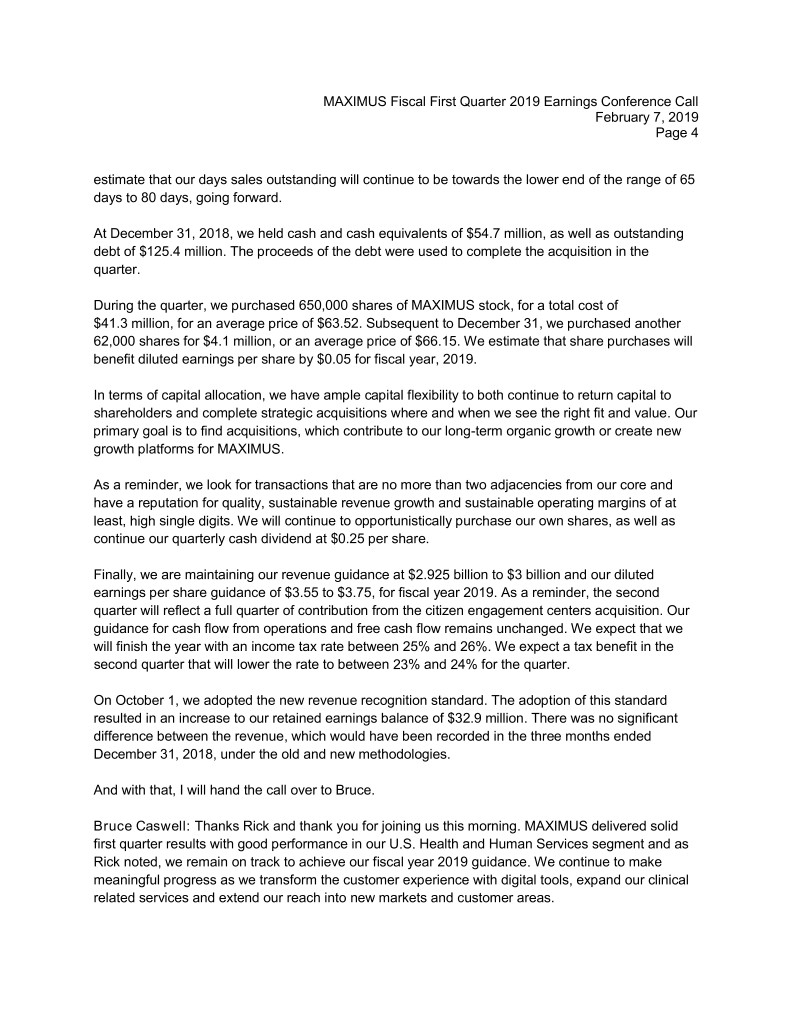
MAXIMUS Fiscal First Quarter 2019 Earnings Conference Call February 7, 2019 Page 4 estimate that our days sales outstanding will continue to be towards the lower end of the range of 65 days to 80 days, going forward. At December 31, 2018, we held cash and cash equivalents of $54.7 million, as well as outstanding debt of $125.4 million. The proceeds of the debt were used to complete the acquisition in the quarter. During the quarter, we purchased 650,000 shares of MAXIMUS stock, for a total cost of $41.3 million, for an average price of $63.52. Subsequent to December 31, we purchased another 62,000 shares for $4.1 million, or an average price of $66.15. We estimate that share purchases will benefit diluted earnings per share by $0.05 for fiscal year, 2019. In terms of capital allocation, we have ample capital flexibility to both continue to return capital to shareholders and complete strategic acquisitions where and when we see the right fit and value. Our primary goal is to find acquisitions, which contribute to our long-term organic growth or create new growth platforms for MAXIMUS. As a reminder, we look for transactions that are no more than two adjacencies from our core and have a reputation for quality, sustainable revenue growth and sustainable operating margins of at least, high single digits. We will continue to opportunistically purchase our own shares, as well as continue our quarterly cash dividend at $0.25 per share. Finally, we are maintaining our revenue guidance at $2.925 billion to $3 billion and our diluted earnings per share guidance of $3.55 to $3.75, for fiscal year 2019. As a reminder, the second quarter will reflect a full quarter of contribution from the citizen engagement centers acquisition. Our guidance for cash flow from operations and free cash flow remains unchanged. We expect that we will finish the year with an income tax rate between 25% and 26%. We expect a tax benefit in the second quarter that will lower the rate to between 23% and 24% for the quarter. On October 1, we adopted the new revenue recognition standard. The adoption of this standard resulted in an increase to our retained earnings balance of $32.9 million. There was no significant difference between the revenue, which would have been recorded in the three months ended December 31, 2018, under the old and new methodologies. And with that, I will hand the call over to Bruce. Bruce Caswell: Thanks Rick and thank you for joining us this morning. MAXIMUS delivered solid first quarter results with good performance in our U.S. Health and Human Services segment and as Rick noted, we remain on track to achieve our fiscal year 2019 guidance. We continue to make meaningful progress as we transform the customer experience with digital tools, expand our clinical related services and extend our reach into new markets and customer areas.

MAXIMUS Fiscal First Quarter 2019 Earnings Conference Call February 7, 2019 Page 5 Let's start off today with the U.S. federal market, which continues to be a priority long-term growth area for us. First, as Rick noted, less than 1% of our federal business was affected by the partial shutdown. This illustrates the critical nature of our business and service offerings in support of essential citizen services and safety net programs. Part and parcel to this are the U.S. federal contracts we acquired in November. These contracts include the primary support vehicle for several of our nation's most critical programs, including the Federal Exchange and Medicare. We successfully transitioned these operations to MAXIMUS during the health plan open enrollment period, which is when the contract is running at peak capacity. I'm very proud to say that there were no disruptions to service and, in fact, customer satisfaction for this open enrollment period improved on these two programs over an already impressive score. Through the transition, I visited some of our newly acquired sites with Tom Romeo, General Manager of MAXIMUS Federal. I can attest to the incredible people we have welcomed to the MAXIMUS family and that, culturally, it is an excellent fit. They are passionate about serving our clients and beneficiaries to our citizen engagement centers and equally dedicated to supporting the communities in which they live and work. I've seen the resilience of our people in Lynn Haven, Florida, following Hurricane Michael. I was excited to hear about our successes in Phoenix, Arizona and we look forward to continuing our site business to welcome our newest employees to MAXIMUS. All in all, the integration is progressing smoothly. Our efforts to expand our clinically related work are also gaining traction in our Federal segment. Recently, we began servicing a new federal agency with subcontracted clinical assessments. While still in the early stages, this required building a network of clinicians and certifying them to perform appraisals. Separately, we took on some new program work as a subcontractor, performing medical record indexing and provider outreach and engagement services. We continue to build capabilities and develop opportunities to leverage our independence and clinical skills in the federal marketplace. Our federal team is also pioneering many of our efforts with respect to our digital transformation strategy. The team is developing new solution sets where we can achieve additional operational and cost efficiencies through techniques such as cloud migration services, artificial intelligence or AI, robotic process automation, RPA, and machine learning. With our increased capabilities, we're implementing new digital innovations within both business process management and as direct service offerings. This will continue to enhance our portfolio of citizen services and federal capabilities. For instance, MAXIMUS offers advanced natural language recognition and are federally certified intelligent virtual assistants, providing interactive conversational speech to beneficiaries. Our technology, now deployed for initial customers, meet stringent federal security requirements and standards. Successful department certification of that new solution opens the door to further agency deployments.
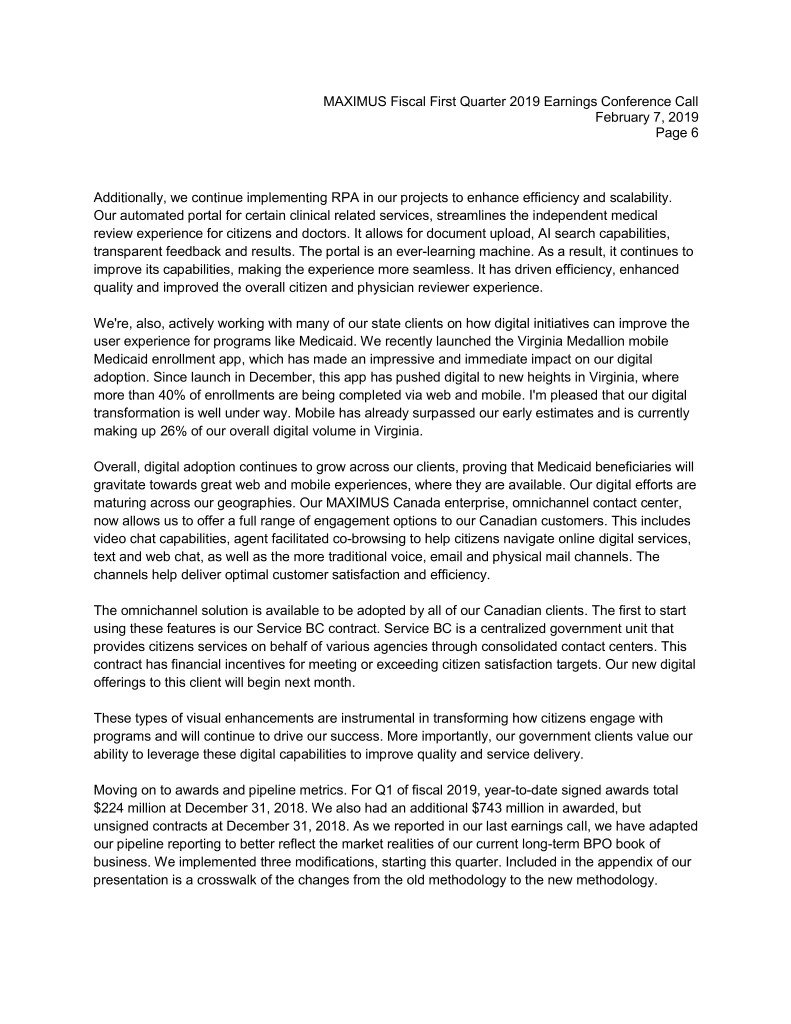
MAXIMUS Fiscal First Quarter 2019 Earnings Conference Call February 7, 2019 Page 6 Additionally, we continue implementing RPA in our projects to enhance efficiency and scalability. Our automated portal for certain clinical related services, streamlines the independent medical review experience for citizens and doctors. It allows for document upload, AI search capabilities, transparent feedback and results. The portal is an ever-learning machine. As a result, it continues to improve its capabilities, making the experience more seamless. It has driven efficiency, enhanced quality and improved the overall citizen and physician reviewer experience. We're, also, actively working with many of our state clients on how digital initiatives can improve the user experience for programs like Medicaid. We recently launched the Virginia Medallion mobile Medicaid enrollment app, which has made an impressive and immediate impact on our digital adoption. Since launch in December, this app has pushed digital to new heights in Virginia, where more than 40% of enrollments are being completed via web and mobile. I'm pleased that our digital transformation is well under way. Mobile has already surpassed our early estimates and is currently making up 26% of our overall digital volume in Virginia. Overall, digital adoption continues to grow across our clients, proving that Medicaid beneficiaries will gravitate towards great web and mobile experiences, where they are available. Our digital efforts are maturing across our geographies. Our MAXIMUS Canada enterprise, omnichannel contact center, now allows us to offer a full range of engagement options to our Canadian customers. This includes video chat capabilities, agent facilitated co-browsing to help citizens navigate online digital services, text and web chat, as well as the more traditional voice, email and physical mail channels. The channels help deliver optimal customer satisfaction and efficiency. The omnichannel solution is available to be adopted by all of our Canadian clients. The first to start using these features is our Service BC contract. Service BC is a centralized government unit that provides citizens services on behalf of various agencies through consolidated contact centers. This contract has financial incentives for meeting or exceeding citizen satisfaction targets. Our new digital offerings to this client will begin next month. These types of visual enhancements are instrumental in transforming how citizens engage with programs and will continue to drive our success. More importantly, our government clients value our ability to leverage these digital capabilities to improve quality and service delivery. Moving on to awards and pipeline metrics. For Q1 of fiscal 2019, year-to-date signed awards total $224 million at December 31, 2018. We also had an additional $743 million in awarded, but unsigned contracts at December 31, 2018. As we reported in our last earnings call, we have adapted our pipeline reporting to better reflect the market realities of our current long-term BPO book of business. We implemented three modifications, starting this quarter. Included in the appendix of our presentation is a crosswalk of the changes from the old methodology to the new methodology.
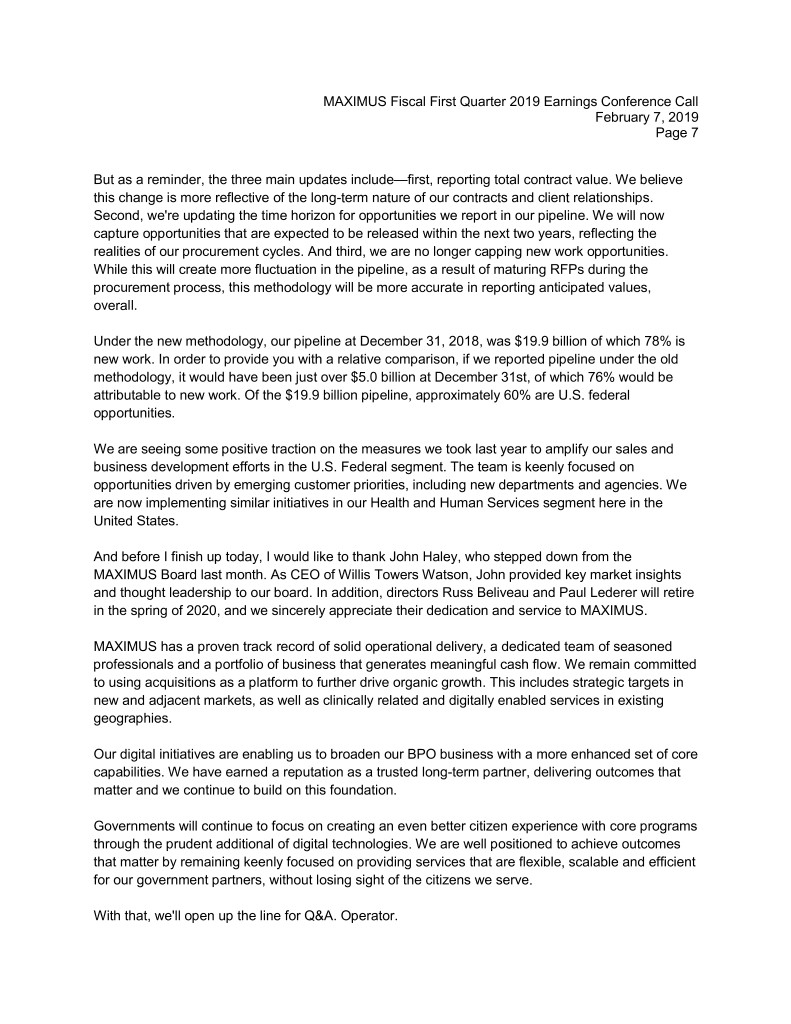
MAXIMUS Fiscal First Quarter 2019 Earnings Conference Call February 7, 2019 Page 7 But as a reminder, the three main updates include—first, reporting total contract value. We believe this change is more reflective of the long-term nature of our contracts and client relationships. Second, we're updating the time horizon for opportunities we report in our pipeline. We will now capture opportunities that are expected to be released within the next two years, reflecting the realities of our procurement cycles. And third, we are no longer capping new work opportunities. While this will create more fluctuation in the pipeline, as a result of maturing RFPs during the procurement process, this methodology will be more accurate in reporting anticipated values, overall. Under the new methodology, our pipeline at December 31, 2018, was $19.9 billion of which 78% is new work. In order to provide you with a relative comparison, if we reported pipeline under the old methodology, it would have been just over $5.0 billion at December 31st, of which 76% would be attributable to new work. Of the $19.9 billion pipeline, approximately 60% are U.S. federal opportunities. We are seeing some positive traction on the measures we took last year to amplify our sales and business development efforts in the U.S. Federal segment. The team is keenly focused on opportunities driven by emerging customer priorities, including new departments and agencies. We are now implementing similar initiatives in our Health and Human Services segment here in the United States. And before I finish up today, I would like to thank John Haley, who stepped down from the MAXIMUS Board last month. As CEO of Willis Towers Watson, John provided key market insights and thought leadership to our board. In addition, directors Russ Beliveau and Paul Lederer will retire in the spring of 2020, and we sincerely appreciate their dedication and service to MAXIMUS. MAXIMUS has a proven track record of solid operational delivery, a dedicated team of seasoned professionals and a portfolio of business that generates meaningful cash flow. We remain committed to using acquisitions as a platform to further drive organic growth. This includes strategic targets in new and adjacent markets, as well as clinically related and digitally enabled services in existing geographies. Our digital initiatives are enabling us to broaden our BPO business with a more enhanced set of core capabilities. We have earned a reputation as a trusted long-term partner, delivering outcomes that matter and we continue to build on this foundation. Governments will continue to focus on creating an even better citizen experience with core programs through the prudent additional of digital technologies. We are well positioned to achieve outcomes that matter by remaining keenly focused on providing services that are flexible, scalable and efficient for our government partners, without losing sight of the citizens we serve. With that, we'll open up the line for Q&A. Operator.
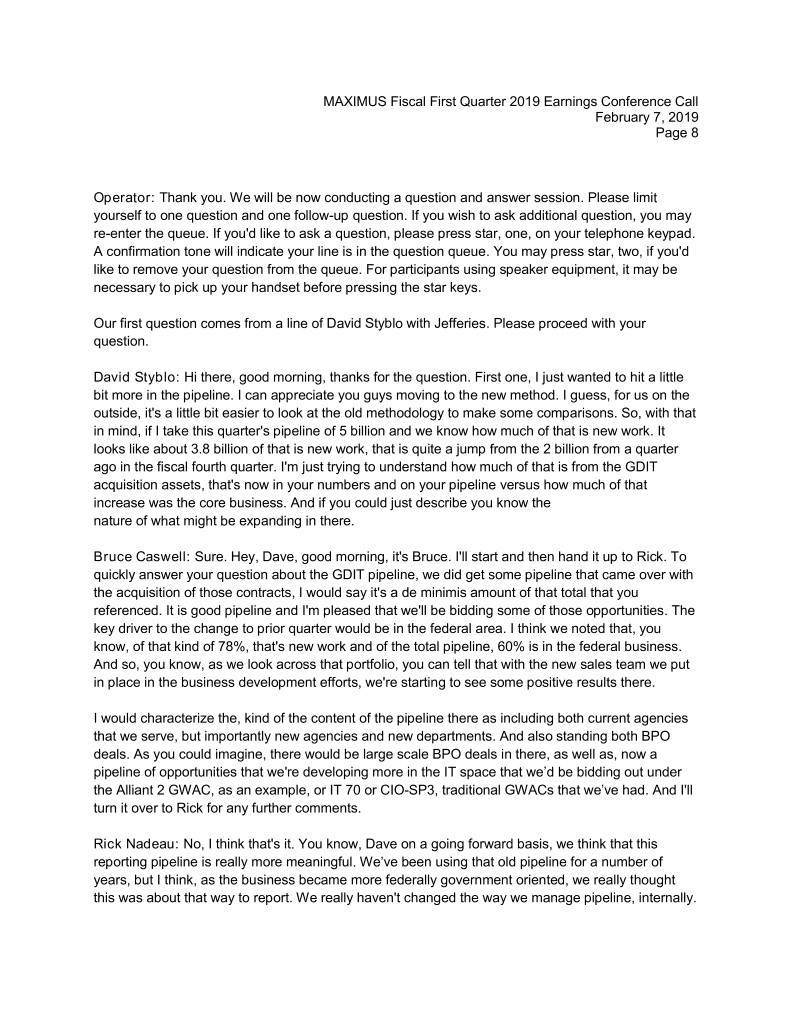
MAXIMUS Fiscal First Quarter 2019 Earnings Conference Call February 7, 2019 Page 8 Operator: Thank you. We will be now conducting a question and answer session. Please limit yourself to one question and one follow-up question. If you wish to ask additional question, you may re-enter the queue. If you'd like to ask a question, please press star, one, on your telephone keypad. A confirmation tone will indicate your line is in the question queue. You may press star, two, if you'd like to remove your question from the queue. For participants using speaker equipment, it may be necessary to pick up your handset before pressing the star keys. Our first question comes from a line of David Styblo with Jefferies. Please proceed with your question. David Styblo: Hi there, good morning, thanks for the question. First one, I just wanted to hit a little bit more in the pipeline. I can appreciate you guys moving to the new method. I guess, for us on the outside, it's a little bit easier to look at the old methodology to make some comparisons. So, with that in mind, if I take this quarter's pipeline of 5 billion and we know how much of that is new work. It looks like about 3.8 billion of that is new work, that is quite a jump from the 2 billion from a quarter ago in the fiscal fourth quarter. I'm just trying to understand how much of that is from the GDIT acquisition assets, that's now in your numbers and on your pipeline versus how much of that increase was the core business. And if you could just describe you know the nature of what might be expanding in there. Bruce Caswell: Sure. Hey, Dave, good morning, it's Bruce. I'll start and then hand it up to Rick. To quickly answer your question about the GDIT pipeline, we did get some pipeline that came over with the acquisition of those contracts, I would say it's a de minimis amount of that total that you referenced. It is good pipeline and I'm pleased that we'll be bidding some of those opportunities. The key driver to the change to prior quarter would be in the federal area. I think we noted that, you know, of that kind of 78%, that's new work and of the total pipeline, 60% is in the federal business. And so, you know, as we look across that portfolio, you can tell that with the new sales team we put in place in the business development efforts, we're starting to see some positive results there. I would characterize the, kind of the content of the pipeline there as including both current agencies that we serve, but importantly new agencies and new departments. And also standing both BPO deals. As you could imagine, there would be large scale BPO deals in there, as well as, now a pipeline of opportunities that we're developing more in the IT space that we’d be bidding out under the Alliant 2 GWAC, as an example, or IT 70 or CIO-SP3, traditional GWACs that we’ve had. And I'll turn it over to Rick for any further comments. Rick Nadeau: No, I think that's it. You know, Dave on a going forward basis, we think that this reporting pipeline is really more meaningful. We’ve been using that old pipeline for a number of years, but I think, as the business became more federally government oriented, we really thought this was about that way to report. We really haven't changed the way we manage pipeline, internally.
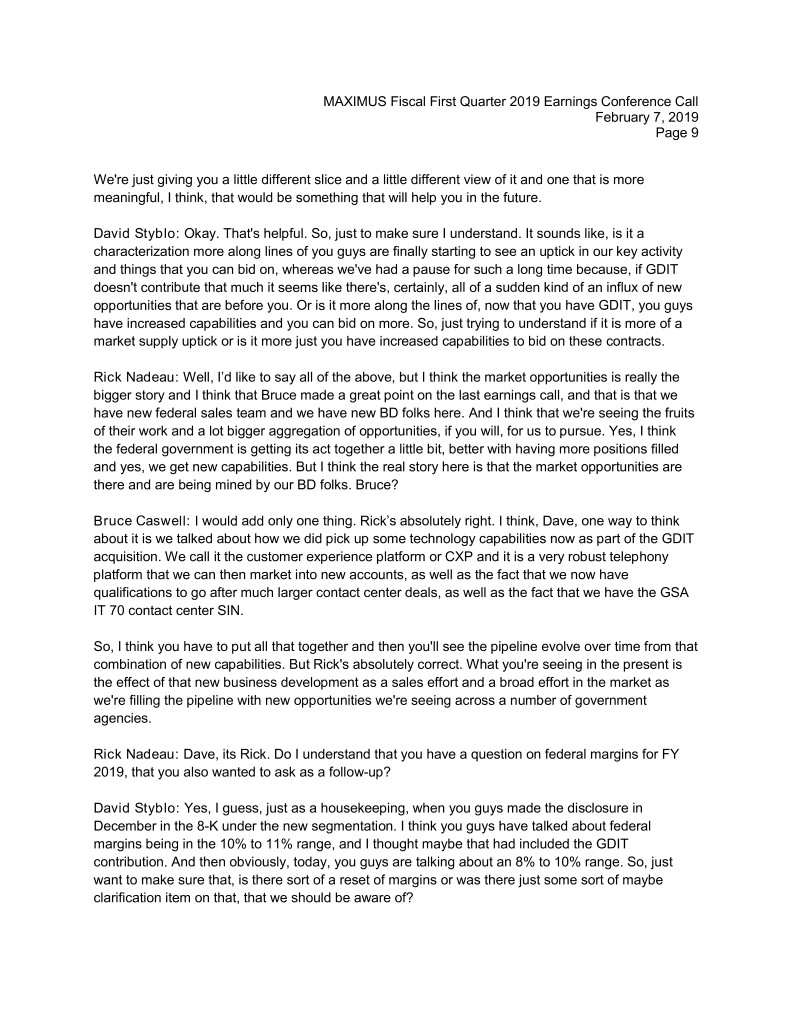
MAXIMUS Fiscal First Quarter 2019 Earnings Conference Call February 7, 2019 Page 9 We're just giving you a little different slice and a little different view of it and one that is more meaningful, I think, that would be something that will help you in the future. David Styblo: Okay. That's helpful. So, just to make sure I understand. It sounds like, is it a characterization more along lines of you guys are finally starting to see an uptick in our key activity and things that you can bid on, whereas we've had a pause for such a long time because, if GDIT doesn't contribute that much it seems like there's, certainly, all of a sudden kind of an influx of new opportunities that are before you. Or is it more along the lines of, now that you have GDIT, you guys have increased capabilities and you can bid on more. So, just trying to understand if it is more of a market supply uptick or is it more just you have increased capabilities to bid on these contracts. Rick Nadeau: Well, I’d like to say all of the above, but I think the market opportunities is really the bigger story and I think that Bruce made a great point on the last earnings call, and that is that we have new federal sales team and we have new BD folks here. And I think that we're seeing the fruits of their work and a lot bigger aggregation of opportunities, if you will, for us to pursue. Yes, I think the federal government is getting its act together a little bit, better with having more positions filled and yes, we get new capabilities. But I think the real story here is that the market opportunities are there and are being mined by our BD folks. Bruce? Bruce Caswell: I would add only one thing. Rick’s absolutely right. I think, Dave, one way to think about it is we talked about how we did pick up some technology capabilities now as part of the GDIT acquisition. We call it the customer experience platform or CXP and it is a very robust telephony platform that we can then market into new accounts, as well as the fact that we now have qualifications to go after much larger contact center deals, as well as the fact that we have the GSA IT 70 contact center SIN. So, I think you have to put all that together and then you'll see the pipeline evolve over time from that combination of new capabilities. But Rick's absolutely correct. What you're seeing in the present is the effect of that new business development as a sales effort and a broad effort in the market as we're filling the pipeline with new opportunities we're seeing across a number of government agencies. Rick Nadeau: Dave, its Rick. Do I understand that you have a question on federal margins for FY 2019, that you also wanted to ask as a follow-up? David Styblo: Yes, I guess, just as a housekeeping, when you guys made the disclosure in December in the 8-K under the new segmentation. I think you guys have talked about federal margins being in the 10% to 11% range, and I thought maybe that had included the GDIT contribution. And then obviously, today, you guys are talking about an 8% to 10% range. So, just want to make sure that, is there sort of a reset of margins or was there just some sort of maybe clarification item on that, that we should be aware of?
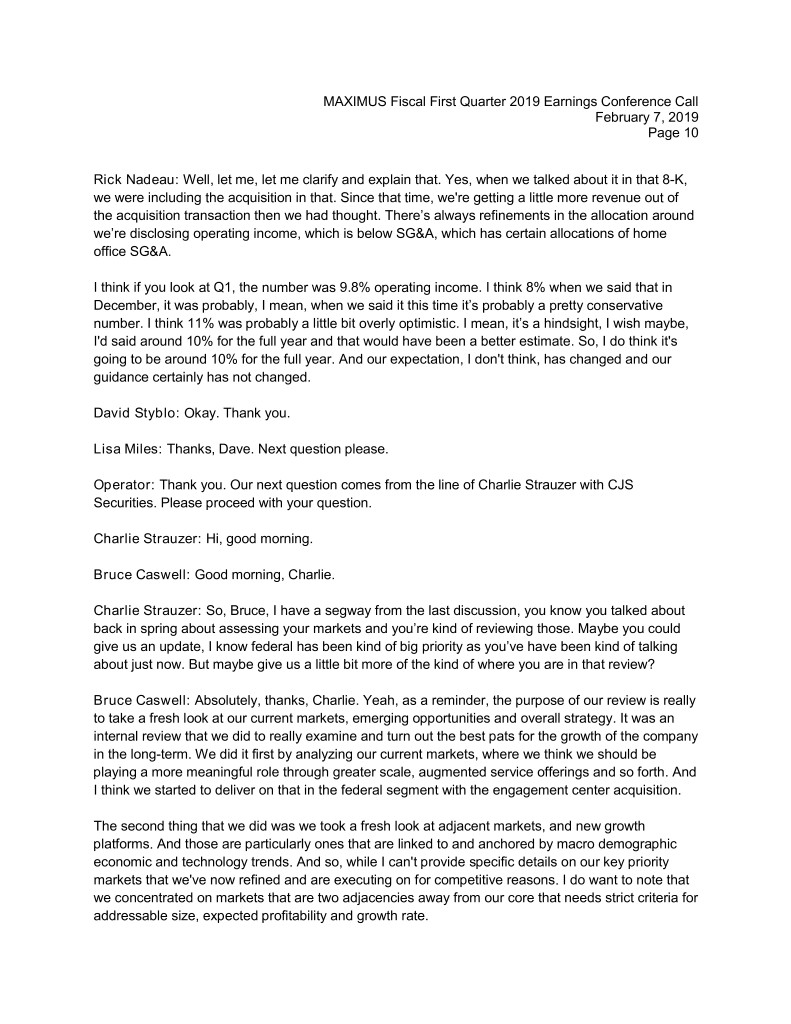
MAXIMUS Fiscal First Quarter 2019 Earnings Conference Call February 7, 2019 Page 10 Rick Nadeau: Well, let me, let me clarify and explain that. Yes, when we talked about it in that 8-K, we were including the acquisition in that. Since that time, we're getting a little more revenue out of the acquisition transaction then we had thought. There’s always refinements in the allocation around we’re disclosing operating income, which is below SG&A, which has certain allocations of home office SG&A. I think if you look at Q1, the number was 9.8% operating income. I think 8% when we said that in December, it was probably, I mean, when we said it this time it’s probably a pretty conservative number. I think 11% was probably a little bit overly optimistic. I mean, it’s a hindsight, I wish maybe, I'd said around 10% for the full year and that would have been a better estimate. So, I do think it's going to be around 10% for the full year. And our expectation, I don't think, has changed and our guidance certainly has not changed. David Styblo: Okay. Thank you. Lisa Miles: Thanks, Dave. Next question please. Operator: Thank you. Our next question comes from the line of Charlie Strauzer with CJS Securities. Please proceed with your question. Charlie Strauzer: Hi, good morning. Bruce Caswell: Good morning, Charlie. Charlie Strauzer: So, Bruce, I have a segway from the last discussion, you know you talked about back in spring about assessing your markets and you’re kind of reviewing those. Maybe you could give us an update, I know federal has been kind of big priority as you’ve have been kind of talking about just now. But maybe give us a little bit more of the kind of where you are in that review? Bruce Caswell: Absolutely, thanks, Charlie. Yeah, as a reminder, the purpose of our review is really to take a fresh look at our current markets, emerging opportunities and overall strategy. It was an internal review that we did to really examine and turn out the best pats for the growth of the company in the long-term. We did it first by analyzing our current markets, where we think we should be playing a more meaningful role through greater scale, augmented service offerings and so forth. And I think we started to deliver on that in the federal segment with the engagement center acquisition. The second thing that we did was we took a fresh look at adjacent markets, and new growth platforms. And those are particularly ones that are linked to and anchored by macro demographic economic and technology trends. And so, while I can't provide specific details on our key priority markets that we've now refined and are executing on for competitive reasons. I do want to note that we concentrated on markets that are two adjacencies away from our core that needs strict criteria for addressable size, expected profitability and growth rate.
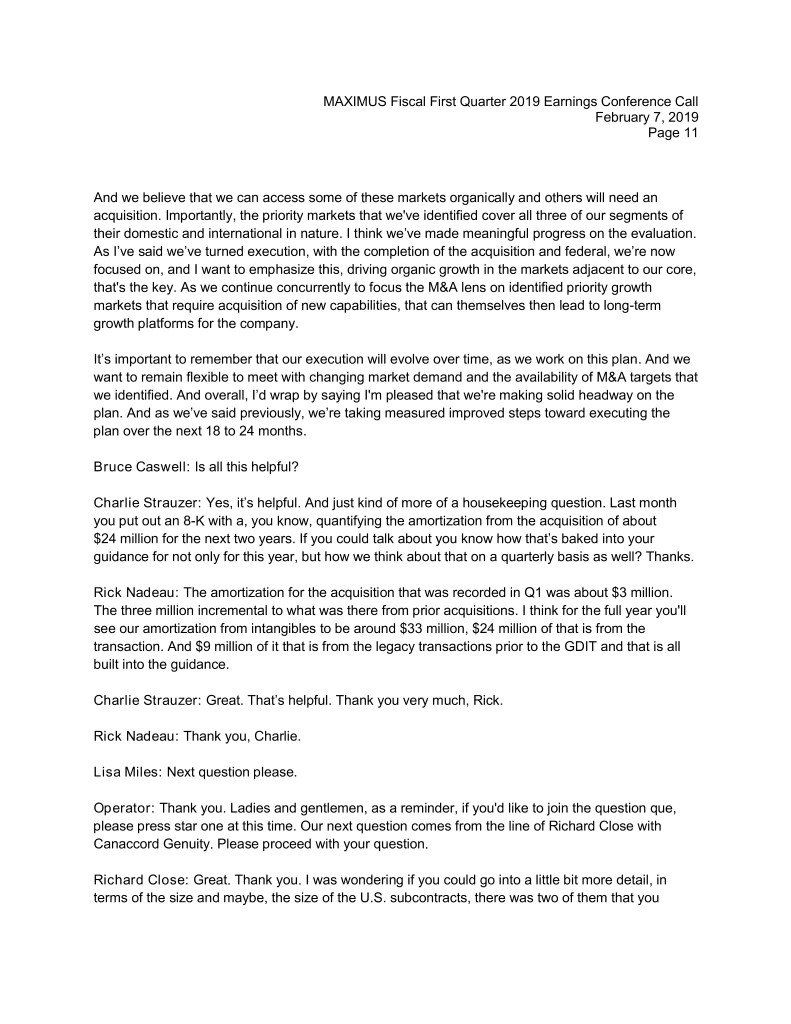
MAXIMUS Fiscal First Quarter 2019 Earnings Conference Call February 7, 2019 Page 11 And we believe that we can access some of these markets organically and others will need an acquisition. Importantly, the priority markets that we've identified cover all three of our segments of their domestic and international in nature. I think we’ve made meaningful progress on the evaluation. As I’ve said we’ve turned execution, with the completion of the acquisition and federal, we’re now focused on, and I want to emphasize this, driving organic growth in the markets adjacent to our core, that's the key. As we continue concurrently to focus the M&A lens on identified priority growth markets that require acquisition of new capabilities, that can themselves then lead to long-term growth platforms for the company. It’s important to remember that our execution will evolve over time, as we work on this plan. And we want to remain flexible to meet with changing market demand and the availability of M&A targets that we identified. And overall, I’d wrap by saying I'm pleased that we're making solid headway on the plan. And as we’ve said previously, we’re taking measured improved steps toward executing the plan over the next 18 to 24 months. Bruce Caswell: Is all this helpful? Charlie Strauzer: Yes, it’s helpful. And just kind of more of a housekeeping question. Last month you put out an 8-K with a, you know, quantifying the amortization from the acquisition of about $24 million for the next two years. If you could talk about you know how that’s baked into your guidance for not only for this year, but how we think about that on a quarterly basis as well? Thanks. Rick Nadeau: The amortization for the acquisition that was recorded in Q1 was about $3 million. The three million incremental to what was there from prior acquisitions. I think for the full year you'll see our amortization from intangibles to be around $33 million, $24 million of that is from the transaction. And $9 million of it that is from the legacy transactions prior to the GDIT and that is all built into the guidance. Charlie Strauzer: Great. That’s helpful. Thank you very much, Rick. Rick Nadeau: Thank you, Charlie. Lisa Miles: Next question please. Operator: Thank you. Ladies and gentlemen, as a reminder, if you'd like to join the question que, please press star one at this time. Our next question comes from the line of Richard Close with Canaccord Genuity. Please proceed with your question. Richard Close: Great. Thank you. I was wondering if you could go into a little bit more detail, in terms of the size and maybe, the size of the U.S. subcontracts, there was two of them that you
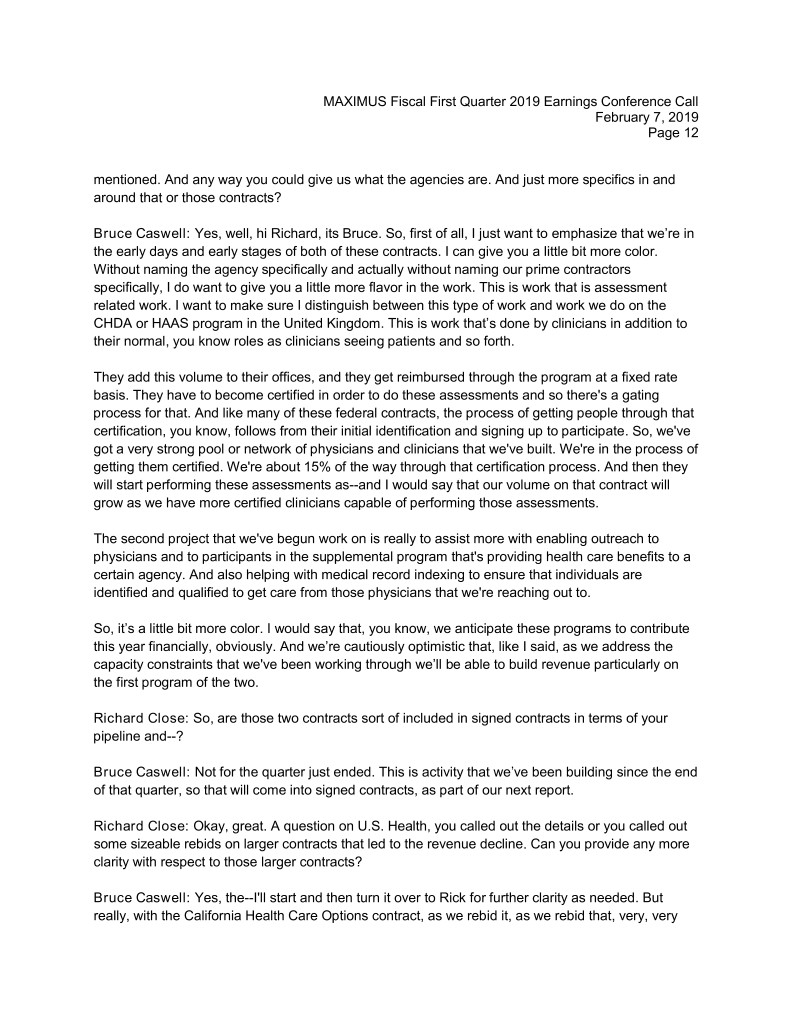
MAXIMUS Fiscal First Quarter 2019 Earnings Conference Call February 7, 2019 Page 12 mentioned. And any way you could give us what the agencies are. And just more specifics in and around that or those contracts? Bruce Caswell: Yes, well, hi Richard, its Bruce. So, first of all, I just want to emphasize that we’re in the early days and early stages of both of these contracts. I can give you a little bit more color. Without naming the agency specifically and actually without naming our prime contractors specifically, I do want to give you a little more flavor in the work. This is work that is assessment related work. I want to make sure I distinguish between this type of work and work we do on the CHDA or HAAS program in the United Kingdom. This is work that’s done by clinicians in addition to their normal, you know roles as clinicians seeing patients and so forth. They add this volume to their offices, and they get reimbursed through the program at a fixed rate basis. They have to become certified in order to do these assessments and so there's a gating process for that. And like many of these federal contracts, the process of getting people through that certification, you know, follows from their initial identification and signing up to participate. So, we've got a very strong pool or network of physicians and clinicians that we've built. We're in the process of getting them certified. We're about 15% of the way through that certification process. And then they will start performing these assessments as--and I would say that our volume on that contract will grow as we have more certified clinicians capable of performing those assessments. The second project that we've begun work on is really to assist more with enabling outreach to physicians and to participants in the supplemental program that's providing health care benefits to a certain agency. And also helping with medical record indexing to ensure that individuals are identified and qualified to get care from those physicians that we're reaching out to. So, it’s a little bit more color. I would say that, you know, we anticipate these programs to contribute this year financially, obviously. And we’re cautiously optimistic that, like I said, as we address the capacity constraints that we've been working through we’ll be able to build revenue particularly on the first program of the two. Richard Close: So, are those two contracts sort of included in signed contracts in terms of your pipeline and--? Bruce Caswell: Not for the quarter just ended. This is activity that we’ve been building since the end of that quarter, so that will come into signed contracts, as part of our next report. Richard Close: Okay, great. A question on U.S. Health, you called out the details or you called out some sizeable rebids on larger contracts that led to the revenue decline. Can you provide any more clarity with respect to those larger contracts? Bruce Caswell: Yes, the--I'll start and then turn it over to Rick for further clarity as needed. But really, with the California Health Care Options contract, as we rebid it, as we rebid that, very, very
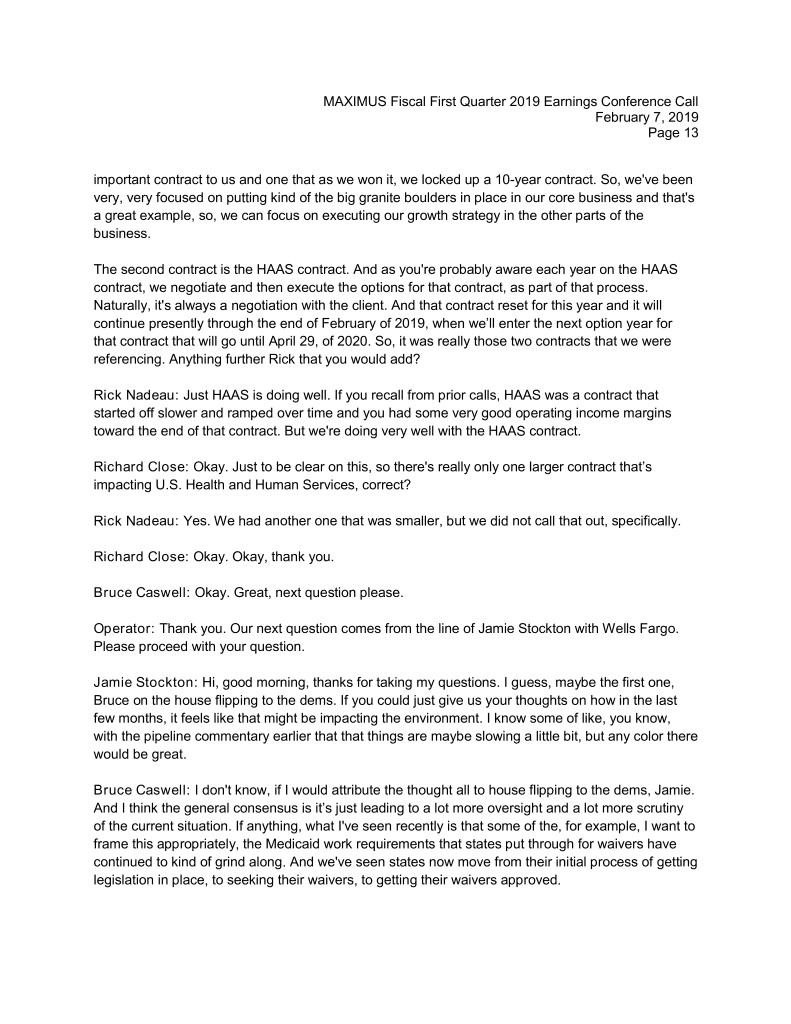
MAXIMUS Fiscal First Quarter 2019 Earnings Conference Call February 7, 2019 Page 13 important contract to us and one that as we won it, we locked up a 10-year contract. So, we've been very, very focused on putting kind of the big granite boulders in place in our core business and that's a great example, so, we can focus on executing our growth strategy in the other parts of the business. The second contract is the HAAS contract. And as you're probably aware each year on the HAAS contract, we negotiate and then execute the options for that contract, as part of that process. Naturally, it's always a negotiation with the client. And that contract reset for this year and it will continue presently through the end of February of 2019, when we’ll enter the next option year for that contract that will go until April 29, of 2020. So, it was really those two contracts that we were referencing. Anything further Rick that you would add? Rick Nadeau: Just HAAS is doing well. If you recall from prior calls, HAAS was a contract that started off slower and ramped over time and you had some very good operating income margins toward the end of that contract. But we're doing very well with the HAAS contract. Richard Close: Okay. Just to be clear on this, so there's really only one larger contract that’s impacting U.S. Health and Human Services, correct? Rick Nadeau: Yes. We had another one that was smaller, but we did not call that out, specifically. Richard Close: Okay. Okay, thank you. Bruce Caswell: Okay. Great, next question please. Operator: Thank you. Our next question comes from the line of Jamie Stockton with Wells Fargo. Please proceed with your question. Jamie Stockton: Hi, good morning, thanks for taking my questions. I guess, maybe the first one, Bruce on the house flipping to the dems. If you could just give us your thoughts on how in the last few months, it feels like that might be impacting the environment. I know some of like, you know, with the pipeline commentary earlier that that things are maybe slowing a little bit, but any color there would be great. Bruce Caswell: I don't know, if I would attribute the thought all to house flipping to the dems, Jamie. And I think the general consensus is it’s just leading to a lot more oversight and a lot more scrutiny of the current situation. If anything, what I've seen recently is that some of the, for example, I want to frame this appropriately, the Medicaid work requirements that states put through for waivers have continued to kind of grind along. And we've seen states now move from their initial process of getting legislation in place, to seeking their waivers, to getting their waivers approved.
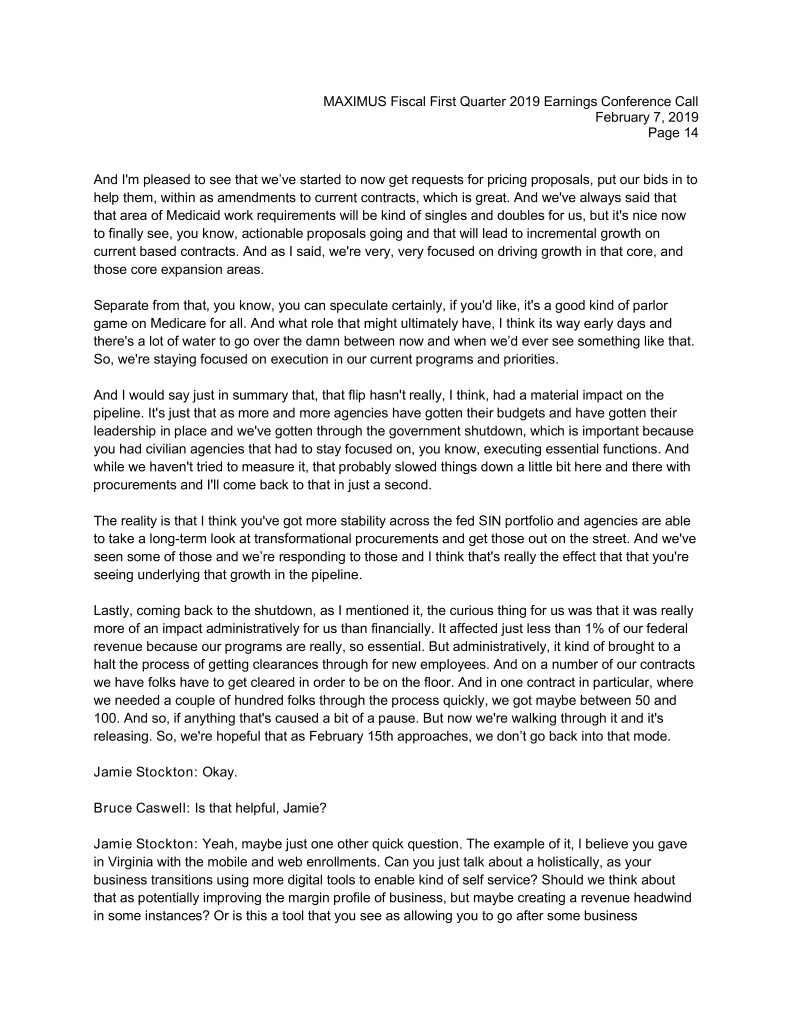
MAXIMUS Fiscal First Quarter 2019 Earnings Conference Call February 7, 2019 Page 14 And I'm pleased to see that we’ve started to now get requests for pricing proposals, put our bids in to help them, within as amendments to current contracts, which is great. And we've always said that that area of Medicaid work requirements will be kind of singles and doubles for us, but it's nice now to finally see, you know, actionable proposals going and that will lead to incremental growth on current based contracts. And as I said, we're very, very focused on driving growth in that core, and those core expansion areas. Separate from that, you know, you can speculate certainly, if you'd like, it's a good kind of parlor game on Medicare for all. And what role that might ultimately have, I think its way early days and there's a lot of water to go over the damn between now and when we’d ever see something like that. So, we're staying focused on execution in our current programs and priorities. And I would say just in summary that, that flip hasn't really, I think, had a material impact on the pipeline. It's just that as more and more agencies have gotten their budgets and have gotten their leadership in place and we've gotten through the government shutdown, which is important because you had civilian agencies that had to stay focused on, you know, executing essential functions. And while we haven't tried to measure it, that probably slowed things down a little bit here and there with procurements and I'll come back to that in just a second. The reality is that I think you've got more stability across the fed SIN portfolio and agencies are able to take a long-term look at transformational procurements and get those out on the street. And we've seen some of those and we’re responding to those and I think that's really the effect that that you're seeing underlying that growth in the pipeline. Lastly, coming back to the shutdown, as I mentioned it, the curious thing for us was that it was really more of an impact administratively for us than financially. It affected just less than 1% of our federal revenue because our programs are really, so essential. But administratively, it kind of brought to a halt the process of getting clearances through for new employees. And on a number of our contracts we have folks have to get cleared in order to be on the floor. And in one contract in particular, where we needed a couple of hundred folks through the process quickly, we got maybe between 50 and 100. And so, if anything that's caused a bit of a pause. But now we're walking through it and it's releasing. So, we're hopeful that as February 15th approaches, we don’t go back into that mode. Jamie Stockton: Okay. Bruce Caswell: Is that helpful, Jamie? Jamie Stockton: Yeah, maybe just one other quick question. The example of it, I believe you gave in Virginia with the mobile and web enrollments. Can you just talk about a holistically, as your business transitions using more digital tools to enable kind of self service? Should we think about that as potentially improving the margin profile of business, but maybe creating a revenue headwind in some instances? Or is this a tool that you see as allowing you to go after some business
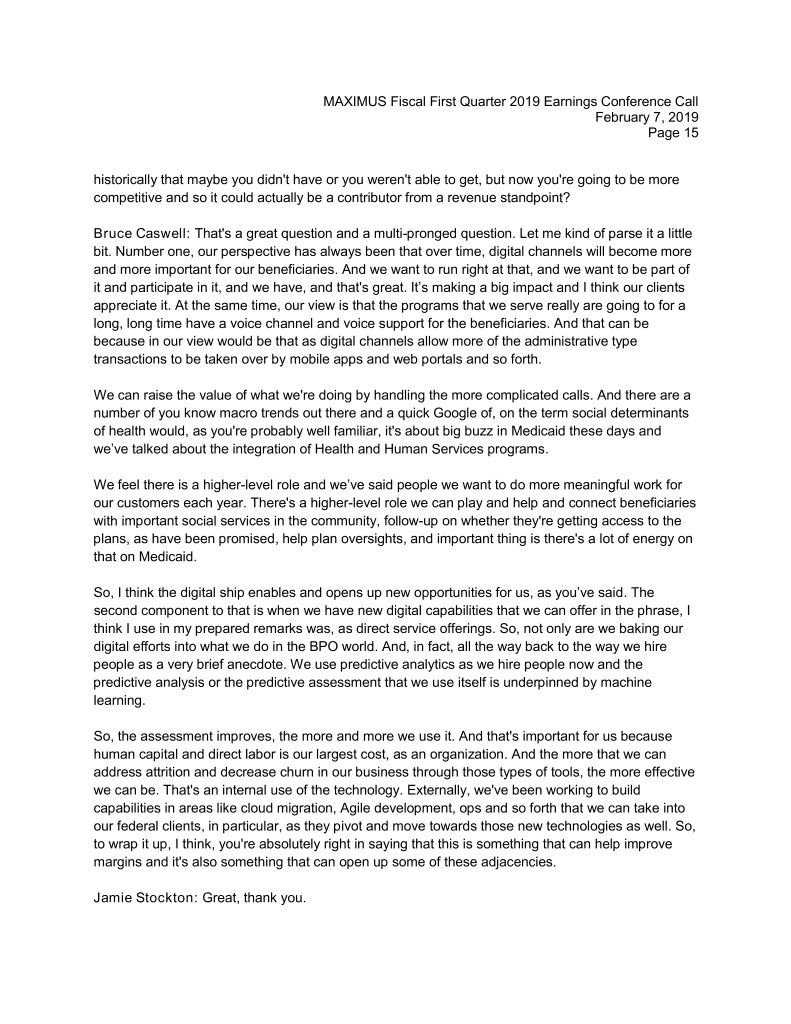
MAXIMUS Fiscal First Quarter 2019 Earnings Conference Call February 7, 2019 Page 15 historically that maybe you didn't have or you weren't able to get, but now you're going to be more competitive and so it could actually be a contributor from a revenue standpoint? Bruce Caswell: That's a great question and a multi-pronged question. Let me kind of parse it a little bit. Number one, our perspective has always been that over time, digital channels will become more and more important for our beneficiaries. And we want to run right at that, and we want to be part of it and participate in it, and we have, and that's great. It’s making a big impact and I think our clients appreciate it. At the same time, our view is that the programs that we serve really are going to for a long, long time have a voice channel and voice support for the beneficiaries. And that can be because in our view would be that as digital channels allow more of the administrative type transactions to be taken over by mobile apps and web portals and so forth. We can raise the value of what we're doing by handling the more complicated calls. And there are a number of you know macro trends out there and a quick Google of, on the term social determinants of health would, as you're probably well familiar, it's about big buzz in Medicaid these days and we’ve talked about the integration of Health and Human Services programs. We feel there is a higher-level role and we’ve said people we want to do more meaningful work for our customers each year. There's a higher-level role we can play and help and connect beneficiaries with important social services in the community, follow-up on whether they're getting access to the plans, as have been promised, help plan oversights, and important thing is there's a lot of energy on that on Medicaid. So, I think the digital ship enables and opens up new opportunities for us, as you’ve said. The second component to that is when we have new digital capabilities that we can offer in the phrase, I think I use in my prepared remarks was, as direct service offerings. So, not only are we baking our digital efforts into what we do in the BPO world. And, in fact, all the way back to the way we hire people as a very brief anecdote. We use predictive analytics as we hire people now and the predictive analysis or the predictive assessment that we use itself is underpinned by machine learning. So, the assessment improves, the more and more we use it. And that's important for us because human capital and direct labor is our largest cost, as an organization. And the more that we can address attrition and decrease churn in our business through those types of tools, the more effective we can be. That's an internal use of the technology. Externally, we've been working to build capabilities in areas like cloud migration, Agile development, ops and so forth that we can take into our federal clients, in particular, as they pivot and move towards those new technologies as well. So, to wrap it up, I think, you're absolutely right in saying that this is something that can help improve margins and it's also something that can open up some of these adjacencies. Jamie Stockton: Great, thank you.
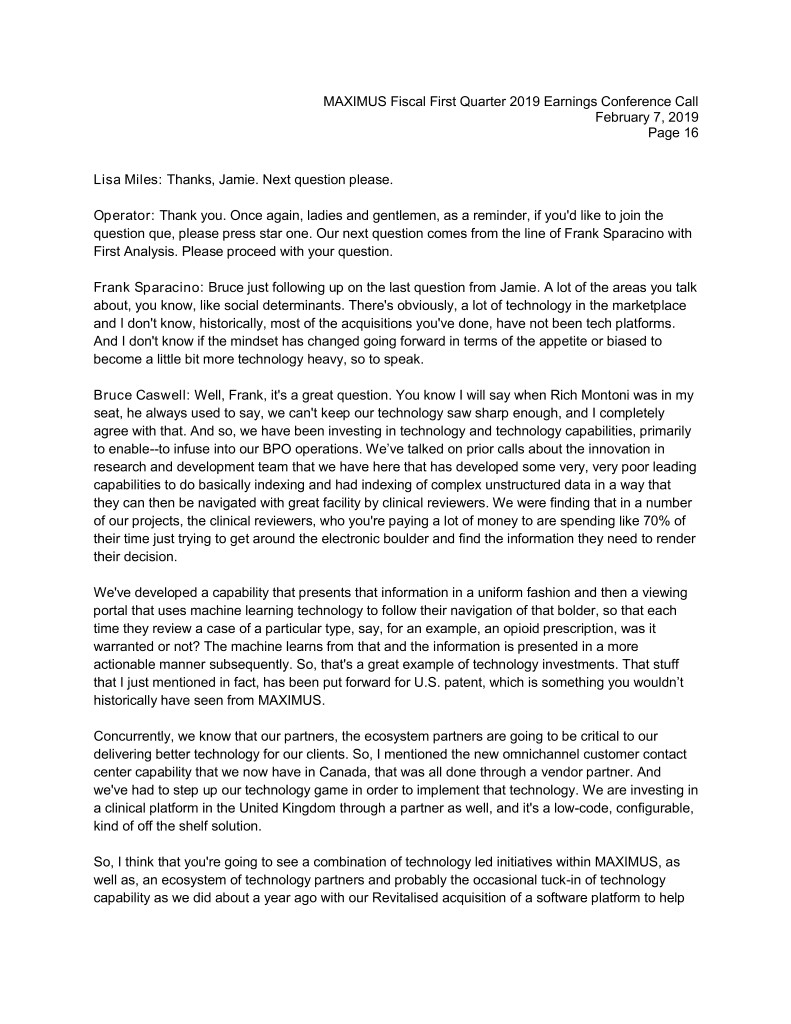
MAXIMUS Fiscal First Quarter 2019 Earnings Conference Call February 7, 2019 Page 16 Lisa Miles: Thanks, Jamie. Next question please. Operator: Thank you. Once again, ladies and gentlemen, as a reminder, if you'd like to join the question que, please press star one. Our next question comes from the line of Frank Sparacino with First Analysis. Please proceed with your question. Frank Sparacino: Bruce just following up on the last question from Jamie. A lot of the areas you talk about, you know, like social determinants. There's obviously, a lot of technology in the marketplace and I don't know, historically, most of the acquisitions you've done, have not been tech platforms. And I don't know if the mindset has changed going forward in terms of the appetite or biased to become a little bit more technology heavy, so to speak. Bruce Caswell: Well, Frank, it's a great question. You know I will say when Rich Montoni was in my seat, he always used to say, we can't keep our technology saw sharp enough, and I completely agree with that. And so, we have been investing in technology and technology capabilities, primarily to enable--to infuse into our BPO operations. We’ve talked on prior calls about the innovation in research and development team that we have here that has developed some very, very poor leading capabilities to do basically indexing and had indexing of complex unstructured data in a way that they can then be navigated with great facility by clinical reviewers. We were finding that in a number of our projects, the clinical reviewers, who you're paying a lot of money to are spending like 70% of their time just trying to get around the electronic boulder and find the information they need to render their decision. We've developed a capability that presents that information in a uniform fashion and then a viewing portal that uses machine learning technology to follow their navigation of that bolder, so that each time they review a case of a particular type, say, for an example, an opioid prescription, was it warranted or not? The machine learns from that and the information is presented in a more actionable manner subsequently. So, that's a great example of technology investments. That stuff that I just mentioned in fact, has been put forward for U.S. patent, which is something you wouldn’t historically have seen from MAXIMUS. Concurrently, we know that our partners, the ecosystem partners are going to be critical to our delivering better technology for our clients. So, I mentioned the new omnichannel customer contact center capability that we now have in Canada, that was all done through a vendor partner. And we've had to step up our technology game in order to implement that technology. We are investing in a clinical platform in the United Kingdom through a partner as well, and it's a low-code, configurable, kind of off the shelf solution. So, I think that you're going to see a combination of technology led initiatives within MAXIMUS, as well as, an ecosystem of technology partners and probably the occasional tuck-in of technology capability as we did about a year ago with our Revitalised acquisition of a software platform to help
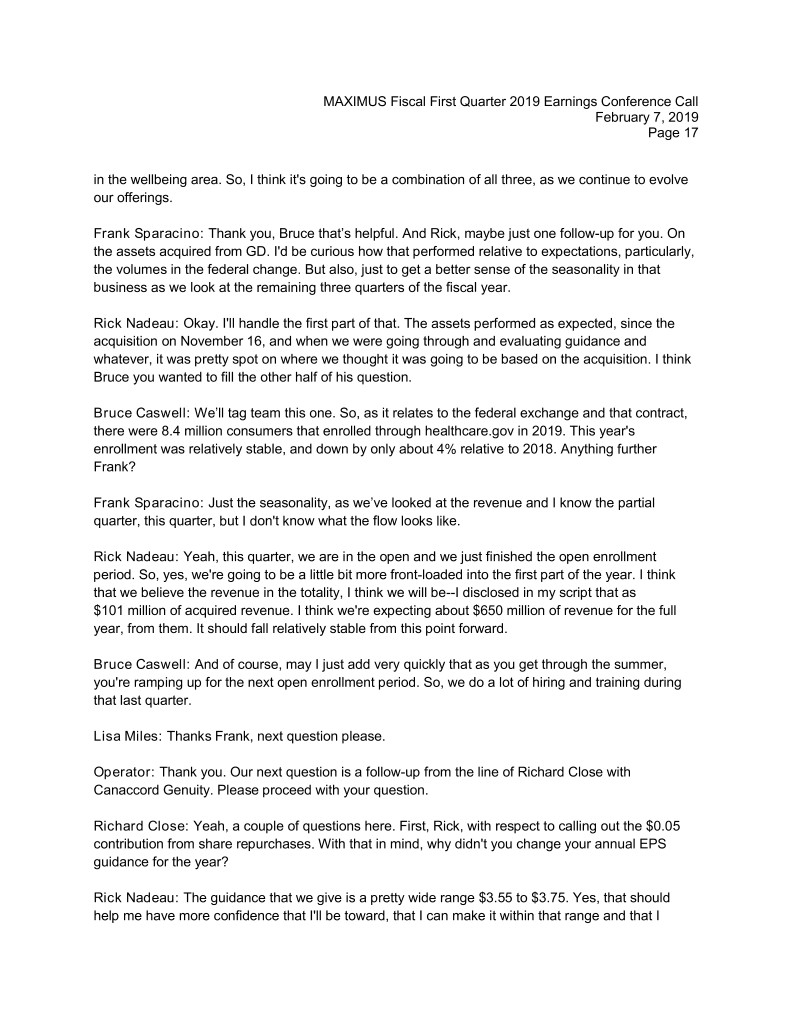
MAXIMUS Fiscal First Quarter 2019 Earnings Conference Call February 7, 2019 Page 17 in the wellbeing area. So, I think it's going to be a combination of all three, as we continue to evolve our offerings. Frank Sparacino: Thank you, Bruce that’s helpful. And Rick, maybe just one follow-up for you. On the assets acquired from GD. I'd be curious how that performed relative to expectations, particularly, the volumes in the federal change. But also, just to get a better sense of the seasonality in that business as we look at the remaining three quarters of the fiscal year. Rick Nadeau: Okay. I'll handle the first part of that. The assets performed as expected, since the acquisition on November 16, and when we were going through and evaluating guidance and whatever, it was pretty spot on where we thought it was going to be based on the acquisition. I think Bruce you wanted to fill the other half of his question. Bruce Caswell: We’ll tag team this one. So, as it relates to the federal exchange and that contract, there were 8.4 million consumers that enrolled through healthcare.gov in 2019. This year's enrollment was relatively stable, and down by only about 4% relative to 2018. Anything further Frank? Frank Sparacino: Just the seasonality, as we’ve looked at the revenue and I know the partial quarter, this quarter, but I don't know what the flow looks like. Rick Nadeau: Yeah, this quarter, we are in the open and we just finished the open enrollment period. So, yes, we're going to be a little bit more front-loaded into the first part of the year. I think that we believe the revenue in the totality, I think we will be--I disclosed in my script that as $101 million of acquired revenue. I think we're expecting about $650 million of revenue for the full year, from them. It should fall relatively stable from this point forward. Bruce Caswell: And of course, may I just add very quickly that as you get through the summer, you're ramping up for the next open enrollment period. So, we do a lot of hiring and training during that last quarter. Lisa Miles: Thanks Frank, next question please. Operator: Thank you. Our next question is a follow-up from the line of Richard Close with Canaccord Genuity. Please proceed with your question. Richard Close: Yeah, a couple of questions here. First, Rick, with respect to calling out the $0.05 contribution from share repurchases. With that in mind, why didn't you change your annual EPS guidance for the year? Rick Nadeau: The guidance that we give is a pretty wide range $3.55 to $3.75. Yes, that should help me have more confidence that I'll be toward, that I can make it within that range and that I
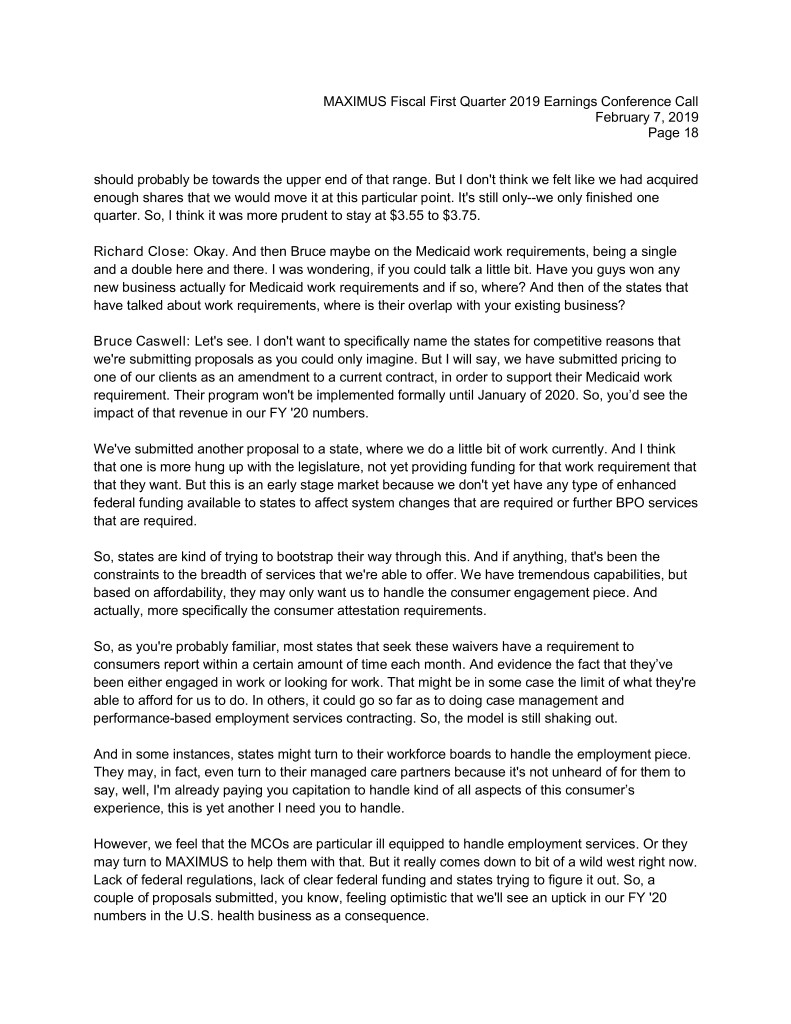
MAXIMUS Fiscal First Quarter 2019 Earnings Conference Call February 7, 2019 Page 18 should probably be towards the upper end of that range. But I don't think we felt like we had acquired enough shares that we would move it at this particular point. It's still only--we only finished one quarter. So, I think it was more prudent to stay at $3.55 to $3.75. Richard Close: Okay. And then Bruce maybe on the Medicaid work requirements, being a single and a double here and there. I was wondering, if you could talk a little bit. Have you guys won any new business actually for Medicaid work requirements and if so, where? And then of the states that have talked about work requirements, where is their overlap with your existing business? Bruce Caswell: Let's see. I don't want to specifically name the states for competitive reasons that we're submitting proposals as you could only imagine. But I will say, we have submitted pricing to one of our clients as an amendment to a current contract, in order to support their Medicaid work requirement. Their program won't be implemented formally until January of 2020. So, you’d see the impact of that revenue in our FY '20 numbers. We've submitted another proposal to a state, where we do a little bit of work currently. And I think that one is more hung up with the legislature, not yet providing funding for that work requirement that that they want. But this is an early stage market because we don't yet have any type of enhanced federal funding available to states to affect system changes that are required or further BPO services that are required. So, states are kind of trying to bootstrap their way through this. And if anything, that's been the constraints to the breadth of services that we're able to offer. We have tremendous capabilities, but based on affordability, they may only want us to handle the consumer engagement piece. And actually, more specifically the consumer attestation requirements. So, as you're probably familiar, most states that seek these waivers have a requirement to consumers report within a certain amount of time each month. And evidence the fact that they’ve been either engaged in work or looking for work. That might be in some case the limit of what they're able to afford for us to do. In others, it could go so far as to doing case management and performance-based employment services contracting. So, the model is still shaking out. And in some instances, states might turn to their workforce boards to handle the employment piece. They may, in fact, even turn to their managed care partners because it's not unheard of for them to say, well, I'm already paying you capitation to handle kind of all aspects of this consumer’s experience, this is yet another I need you to handle. However, we feel that the MCOs are particular ill equipped to handle employment services. Or they may turn to MAXIMUS to help them with that. But it really comes down to bit of a wild west right now. Lack of federal regulations, lack of clear federal funding and states trying to figure it out. So, a couple of proposals submitted, you know, feeling optimistic that we'll see an uptick in our FY '20 numbers in the U.S. health business as a consequence.
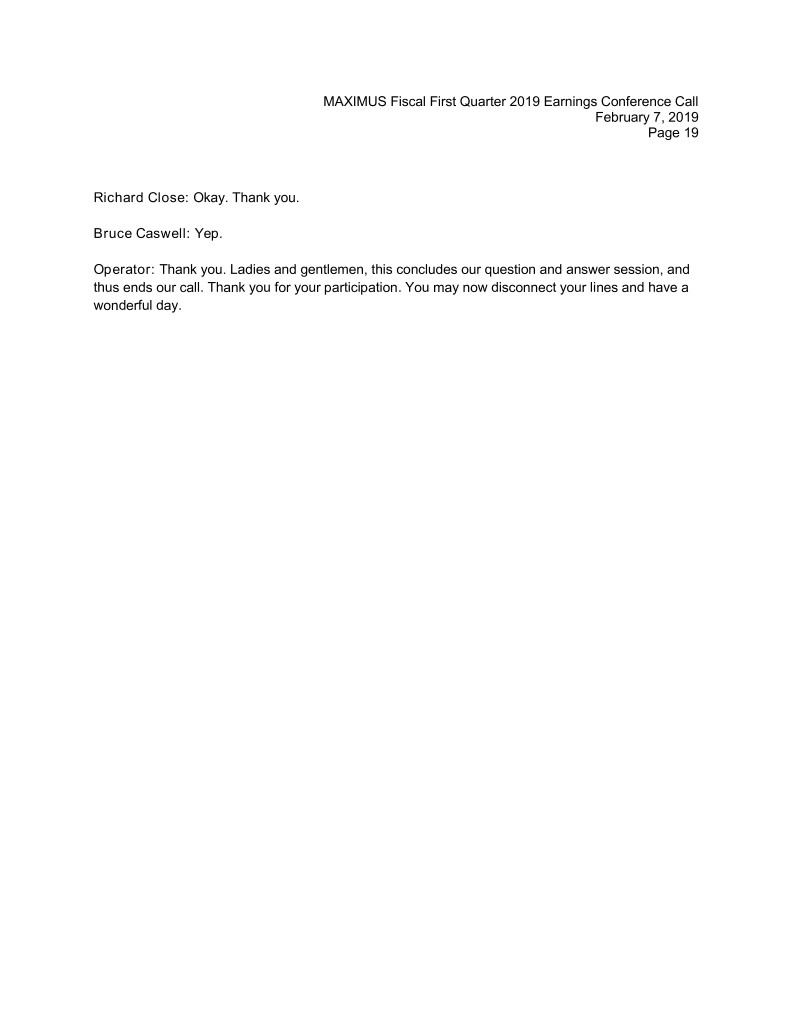
MAXIMUS Fiscal First Quarter 2019 Earnings Conference Call February 7, 2019 Page 19 Richard Close: Okay. Thank you. Bruce Caswell: Yep. Operator: Thank you. Ladies and gentlemen, this concludes our question and answer session, and thus ends our call. Thank you for your participation. You may now disconnect your lines and have a wonderful day.